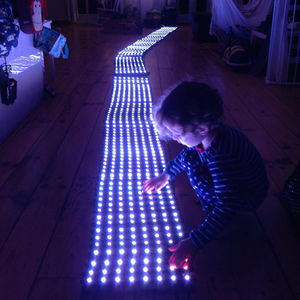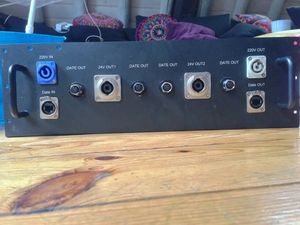Difference between revisions of "LINSN LED strips"
(→Teardown) |
(→Head-units) |
||
| Line 57: | Line 57: | ||
== Head-units == | == Head-units == | ||
| − | + | [[File:Head-unit-front.jpg|thumb|19" headunit, note that 'date' is indeed the singular of 'data'.. right ?]] | |
== Boards / Boxes == | == Boards / Boxes == | ||
Revision as of 13:46, 26 September 2013
| Projects | |
|---|---|

| |
| Participants | Epidemik, Justa |
| Skills | Basic electronics, Reverse engineering firmware |
| Status | Active |
| Niche | Electronics |
| Purpose | Fun |
Contents
Background
Owner of the LED mats has about 40m2 in total, has multiple power supplies but no "control box". The power supplies contain a Receiver Card, the missing component is the Sender Card.
The owner would like to hang some mats on the side of his van when parked at events, so he can display text (dynamically). Since he only needs a small amount of the mats, the unused mats need the same.
Manufacturer/Distrubutor/Model
[LINSN LED] seems to be the chinese manufacturer of the hardware that [Radiant Opto Electronics] sells on the western market.
The led-panels in question seems to be the [LED Curtain Screen Linx-30(?)] and have been supplied with 19" 'head-units' that contain supporting electronics. The system lacks a 'driver' card that belongs to it; nor is there any software supplied with what we have, currently.
Teardown
LED-panel
The LED-panels consist of strips with 8 RGB-LED's each and are mechanically connected together by two braided nylon-strips along both sides. Electronically they are linked together by a 2-wire power-bus (24Volt) and a 4-wire databus (serial data, clock, latch and (most likely) OutputEnable, see below).
Each strip has a small switch-mode power-supply on the edge that has the power-connector on it; this supplies both LED's as well as supporting logic.
The data-bus seems to be be built in the following manner:
- In-connector->(half of) octal transceiver->16-bit shift register 1->16 bit shift-register 2->(half of)octal transceiver->Out->connector
Effectively, this creates a single long shift-register of 32-bits per LED-strip with signal reconditioning at the in and output sides. The LEDs are linked to the outputs of the shift-register which have 'Latch', 'Clock' and 'OutputEnable' in a paralel-bus topology with the other strips, the 'SerialDataIn' signal is fed 'through' each shift-register in turn.
One thing that needs to be investigated is how each 16-bit shift-register seems responsible for only 12 outputs (4 x RGB LED). Is there perhaps a function for the extra 4 bit positions ?
The first and last strips in each mat link to female/male connectors respectively that will allow you to daisy-chain both power and data-buses to a next mat of led-strips.
[16-bit Shift Register with latch, output-enable and adjustabble constant-current drivers:]
- MBI5024GP <-- partnumber; made by 'Macroblock'
- DP317811HB <-- Trackingnumber
Abridged specs:
- 16 Bit shift-register with serial in, clock and output-enable and latch-function
- 25 MHZ clock freq.
- 5v/3.3v capable
- constant-current up to 3-45mA@VDD=5V or 3-30mA@VDD=3.3V , set by resistor on reference-input.
8-port bi-directional high-Z transciever (aka: [octal line driver]) or [Octal Bus transceiver, 3-state])
- (74)HC245 <-- 74xx series TTL 'Highspeed Cmos', partnumber 245
- 9A8D407 <-- Internal numbering/tracking/package-info
- UuG920E <-- Same
- NXP <-- NXP corp; formerly Philips Semiconductors
Head-units
Boards / Boxes
Receiving Card: http://www.ledcontrolcard.com/led-receiving-card-c-15_20/linsn-rv802-led-receiving-card-p-46.html
Sending Card (?): http://www.ledcontrolcard.com/led-sending-card-c-15_19/linsn-ts801d-led-control-cardsd801d-and-l202-led-card-p-4.html
Photos
Suggested Approach
- Using a Logic Analyzer to sniff the data between a Sending- and Receiving Card.
